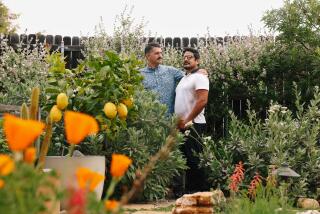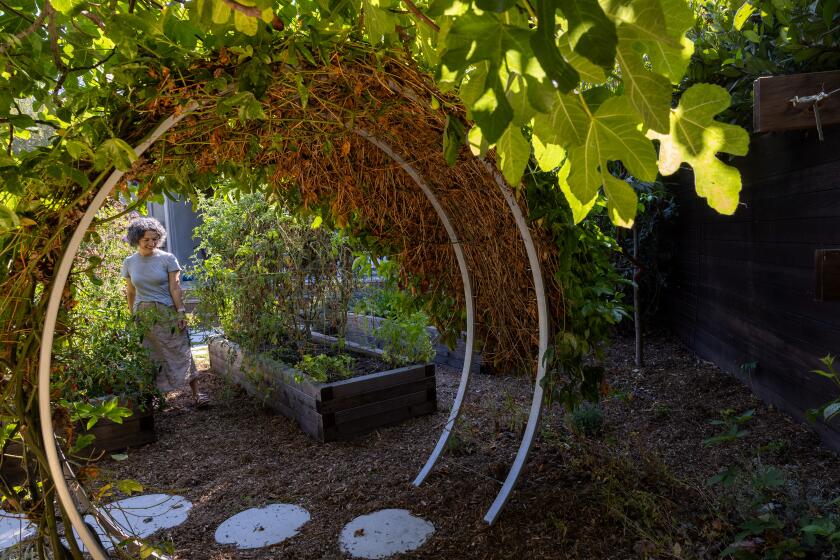Poinsettia Pioneer Still Does Blooming Business
ENCINITAS, Calif. — “Bright scarlet weeds growing wild on the hillside” have been developed into the popular poinsettias that adorn homes and offices all over America each Christmas season.
In 1906, German immigrant Albert Ecke began growing fresh flowers commercially in fields at Hollywood.
Ecke raised gladiolus, chrysanthemums and poinsettias for the fresh flower market in Los Angeles. Within a few years, Ecke and later his young son, Paul Ecke Sr., began specializing in cultivating poinsettias as potted plants.
“When the Eckes came here, they found bright scarlet weeds growing wild on the hillside,” said Carolyn Mack, the company’s public relations director. She speculates that Catholic priests imported poinsettias from Mexico where Franciscan fathers began using them in a nativity procession in the 17th Century.
“Paul Ecke Sr. was fascinated by them as a little boy and pioneered worldwide production,” Mack adds. “He really established the poinsettia as part of the Christmas season.”
Eight decades later, almost all poinsettia production involves, in some way, the Paul Ecke Poinsettia Ranch, now located at Encinitas less than 10 miles north of San Diego.
“We are the major supplier to poinsettia growers throughout the world,” said Paul Ecke Jr., who now runs the company. “We supply more than 90% of all mother plants.”
Between January and June, the Ecke nursery sells cuttings three to four inches tall to other nurseries.
“They use them as mother plants,” Ecke explains. “They nurture them, pinch them and grow them.”
Mother Plants
Cuttings from those mother plants provide nurseries with poinsettias for their markets each winter.
Ecke says nurseries often prefer to raise other types of flowers in the greenhouse space that would be needed if they developed their own poinsettia mother plants.
On the other hand, “we specialize in poinsettias,” Ecke adds. “We have responsibility for poinsettias all year long. We send out several million cuttings to our grower customers every year.”
The company also grows plants for sale to retail florists, mostly in Southern California and Arizona.
“The market season is expanding,” Mack says. “Many people want poinsettias right after Thanksgiving now.”
An early crop is ready for market by mid November.
Those bright red flowers perched atop bright green leaves on poinsettia plants really aren’t flowers at all, Ecke notes. They are shaped like the leaves and technically are called bracts.
“The colored bracts are modified leaves, modified foliage,” Ecke says. “The little podlike buttons in the center are the real flower.”
Not all poinsettia bracts are bright red anymore because of the third aspect of the Ecke business: research.
The ranch’s principal breeder, Franz Fruehwirth, begins with 10,000 to 15,000 new seedlings each year and eliminates all but about 20 after the first year of tests. Eventually, those survivors are reduced to one or two varieties that might stand a chance of becoming commercial.
“So many times it breaks your heart, but you have to bite the bullet and eliminate it because it doesn’t have the desired characteristics,” Fruehwirth says.
The research has led to such new varieties as a poinsettia in which the bracts range from marbled pink on an off-white background and another with pink flecks on the traditional red background.
Research also has produced varied forms of plants ranging from masses of red foliage, to a single red bract on each plant, to a small plant in a plastic holder.
A plant with brighter reds and darker greens than standard poinsettias also is being introduced.
“If there is a poor light source, a plant can look dull where otherwise it would look bright, so we are trying to breed varieties that look good under every light source,” Ecke says.
900-Acre Ranch
The company’s poinsettia production and research are centered on a 900-acre ranch, including 35 acres of greenhouses, all located just off U.S. 5 a mile from the Pacific Ocean. Ecke said the climate is ideal because it doesn’t get too warm in the summer or too cold in the winter for flowers to grow.
Ninety percent of the company’s poinsettias still bear the traditional red foliage, but Ecke feels other shades show the possibilities for variety and improvement.
“To get something that is better is difficult; to get something different is not too hard,” he says.






